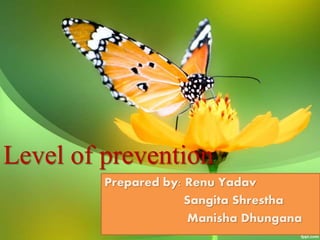
Levels of prevention from primordial to tertiary
- 1. Level of prevention Prepared by: Renu Yadav Sangita Shrestha Manisha Dhungana
- 2. Prevention: • Prevention is the action aimed at eradicating, eliminating or minimizing the impact of disease and disability, or if none of these are feasible, retarding the progress of the disease and disability.
- 4. Primordial prevention: • Primordial prevention is defined as prevention of risk factors themselves, beginning with change in social and environmental conditions in which these factors are observed to develop, and continuing for high risk children, adolescents and young adults. • It is the prevention of the emergence or development of risk factors in countries or population groups in which they have not yet appeared. • The main intervention in primordial prevention is through individual and mass education.
- 5. Cont… • Primordial prevention, a relatively new concept, is receiving special attention in the prevention of chronic diseases. For example, many adult health problems (e.g. obesity, hypertension) have their early origins in childhood, because this is the time when lifestyles are formed(for example, smoking, eating patterns, physical exercise). • Primordial prevention begins in childhood when health risk behaviour begins. Parents, teachers and peer groups are important in imparting health education to children.
- 6. Examples: • National policies and programes on nutrition involving the agricultural sector, the food industry, and the food import- export sector • Comprehensive policies to discourage smoking • Programes to promote regular physical activity • Making major changes in lifestyle
- 7. Primary prevention: • Primary prevention can be defined as the action taken prior to the onset of disease, which removes the possibility that the disease will ever occur. • It signifies intervention in the pre-pathogenesis phase of a disease or health problem. • Primary prevention may be accomplished by measures of “Health promotion” and “specific protection”
- 8. Primary prevention (cont.) • It includes the concept of "positive health", a concept that encourages achievement and maintenance of "an acceptable level of health that will enable every individual to lead a socially and economically productive life". • Primary prevention may be accomplished by measures designed to promote general health and well-being, and quality of life of people or by specific protective measures.
- 9. Primary prevention Specific protectionHealth promotion Achieved by Health education Environmental modifications Nutritional interventions Life style and behavioral changes Immunization and seroprophylaxis chemoprophylaxis Use of specific nutrients or supplementations Protection against occupational hazards Safety of drugs and foods Control of environmental hazards, e.g. air pollution Achieved by
- 10. Approaches for Primary Prevention: • The WHO has recommended the following approaches for the primary prevention of chronic diseases where the risk factors are established: – a. Population (mass) strategy – b. High -risk strategy
- 11. Population (mass) strategy: • “Population strategy" is directed at the whole population irrespective of individual risk levels. • For example, studies have shown that even a small reduction in the average blood pressure or serum cholesterol of a population would produce a large reduction in the incidence of cardiovascular disease • The population approach is directed towards socio-economic, behavioral and lifestyle changes
- 12. High -risk strategy: • The high -risk strategy aims to bring preventive care to individuals at special risk. • This requires detection of individuals at high risk by the optimum use of clinical methods.
- 13. Secondary prevention: • It is defined as “ action which halts the progress of a disease at its incipient stage and prevents complications.” • The specific interventions are: early diagnosis (e.g. screening tests, breast self examination, pap smear test, radiographic examinations, case finding programme, etc) and adequate treatment.
- 14. Cont.. • Secondary prevention attempts to arrest the disease process, restore health by seeking out unrecognized disease and treating it before irreversible pathological changes take place, and reverse communicability of infectious diseases. • It thus protects others from in the community from acquiring the infection and thus provide at once secondary prevention for the infected ones and primary prevention for their potential contacts.
- 15. Early diagnosis and treatment • WHO Expert Committee in 1973 defined early detection of health disorders as “ the detection of disturbances of homoeostatic and compensatory mechanism while biochemical, morphological and functional changes are still reversible.” • The earlier the disease is diagnosed, and treated the better it is for prognosis of the case and in the prevention of the occurrence of other secondary cases.
- 16. Tertiary prevention: • It is used when the disease process has advanced beyond its early stages. • It is defined as “all the measures available to reduce or limit impairments and disabilities, and to promote the patients’ adjustment to irremediable conditions.” • Intervention that should be accomplished in the stage of tertiary prevention are disability limitation, and rehabilitation.
- 18. Impairment: • Impairment is “any loss or abnormality of psychological, physiological or anatomical structure or function.” Disability: • Disability is “any restriction or lack of ability to perform an activity in the manner or within the range considered normal for the human being.”
- 19. Handicap: • Handicap is termed as “a disadvantage for a given individual, resulting from an impairment or disability, that limits or prevents the fulfillment of a role in the community that is normal (depending on age, sex, and social and cultural factors) for that individual.” Rehabilitation: • Rehabilitation is “ the combined and coordinated use of medical, social, educational, and vocational measures for training and retraining the individual to the highest possible level of functional ability.”
- 21. Strategy for Prevention Assess Exposure Identify Populations at High Disease Risk (based on demography / family history, host factors..) Conduct Research on Mechanisms (including the study of genetic susceptibility) Apply Population-Based Intervention Programs Evaluate Intervention Programs Modify Existing Intervention Programs
